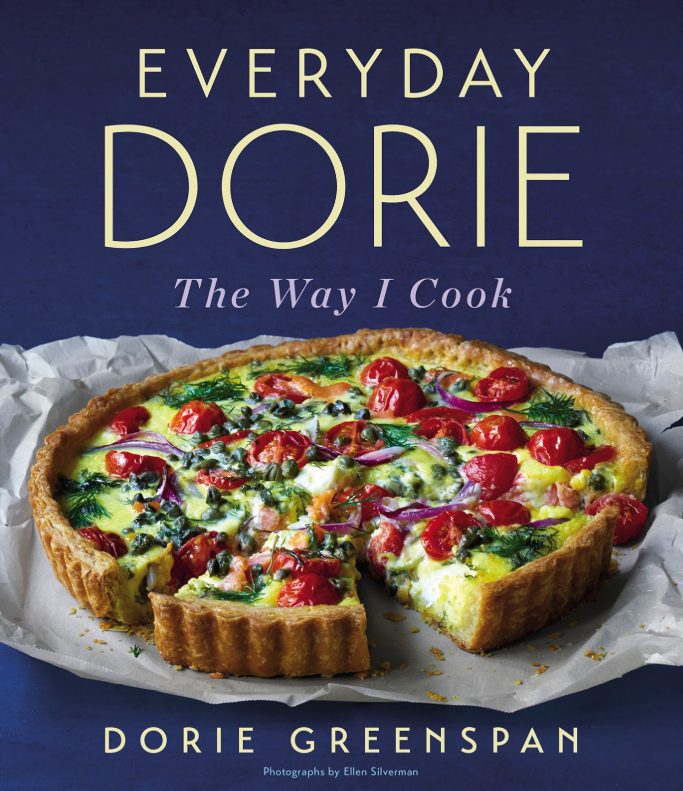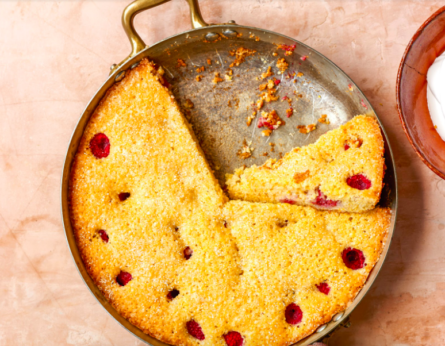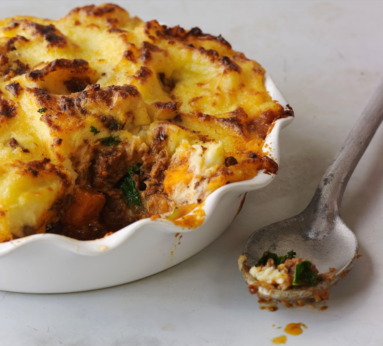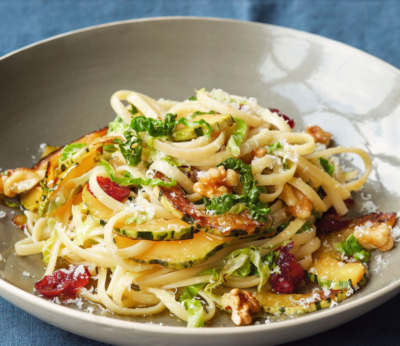Twice a month our writer cooks from the book and decides if these farm-to-table recipes are worth the investment.

You know Dorie Greenspan, either because you’re a Francophile who envies her epicurean Parisian life, or because you love baking and, well, she’s pretty good at that. But her new book, Everyday Dorie (Rux Martin Books/Houghton Mifflin Harcourt; $35) is focused on neither of these. The recipes in here are what Dorie cooks on a Tuesday night, after changing into track pants and scouring the crisper bin. (I’m kidding; Dorie would never wear track pants.) These dishes are both practical and delicious, bringing together a global pantry of flavors as Dorie lets you know what you can make ahead, how to store and reheat it, and how to adapt the recipe to whatever you found in your crisper bin. And while these dishes are straightforward and unpretentious, there’s plenty in here to serve up to guests, unexpected or not, including a generous dessert selection.
On a recent Saturday, I made the Mediterranean Shepherd’s Pie for friends because miserable fall weather means that I need extra mashed potatoes in my life. The filling is made with a mix of ground meat and sausage, and she encourages you to choose pretty much whatever combo you want—I went with ground turkey and pork sausage. Veggie-wise, there are crushed tomatoes, butternut squash and spinach. It’s all seasoned with flavors from the southern shores of the Med: cumin, sumac, harissa paste and za’atar, before being topped with buttery mashed potatoes and baked. Not to brag, but some said this was the best shepherd’s pie they had eaten.
I also made the Cornmeal-Buttermilk Loaf Cake, and like the pie, the recipe is practically bulletproof. Dorie is a real hand-holder, meaning those brand new to the kitchen will be able to pull off most of these recipes. But experienced cooks are going to love the flavors, Dorie’s insights and the sheer dependability of these dishes.
Copy line: Recipes are excerpted from EVERYDAY DORIE © 2018 by Dorie Greenspan. Photography © 2018 by Ellen Silverstein. Reproduced by permission of Rux Martin Books/Houghton Mifflin Harcourt. All rights reserved.
CORNMEAL-BUTTERMILK LOAF CAKE, WITH OR WITHOUT BERRIES
Servings: 8
When you bake as much as I do, which is just about daily, it’s hard to have favorites, and harder to bake those favorites often. But I always find time for this cake. It’s one of the simplest, plainest cakes I make, and yet its appeal is so strong that it’s become a standard. It’s a great weekend cake — it’ll last the weekend and beyond; it’s a terrific cake to take anywhere as a host/house gift; and, if you’re like my husband and son, you’ll love the cake cut into thick slices and toasted. They slather it with butter — so unnecessary, but so good; I sometimes pile it with jam (also unnecessary).
The cornmeal in the batter adds a slight roughness to the texture and a beautiful sunny color, and the buttermilk moderates the sweetness and saves the cake from being too rich for breakfast. If you want, add the finely grated zest of a lemon, a lime or half an orange to the batter (rub the zest into the sugar before you beat in the eggs).
This recipe started its happy life as a skillet cake, and it’s still the version l most often make for brunch, cutting the cake into wedges and turning it into a kind of shortcake. But if you’re looking for portability, the loaf’s the way to go.
STORING: Wrapped in plastic, the cake will keep at room temperature for at least 3 days; if it stales, toast slices. The cake can be frozen for up to 2 months.
- 1¼ cups (170 grams) all-purpose flour
- ½ cup (86 grams) yellow cornmeal
- 1 teaspoon baking powder
- ¼ teaspoon baking soda
- ¼ teaspoon fine sea salt
- 2 large eggs, at room temperature
- 1 cup (200 grams) sugar
- 2 teaspoons pure vanilla extract
- ½ cup (120 ml) buttermilk (well shaken before measuring), at room temperature
- 1 stick (8 tablespoons; 4 ounces; 113 grams) unsalted butter, melted and cooled
- About 1 cup (150 grams) fresh blueberries or
- raspberries (optional)

Whisk together the flour, cornmeal, baking powder, baking soda and salt.
Whisk the eggs and sugar together in a large bowl until well blended, a minute or two. Whisk in the vanilla. Switch to a flexible spatula and gently stir in half of the dry ingredients. Blend in the buttermilk and then add the rest of the dry ingredients, mixing gently until fully incorporated. Gradually stir in the melted butter. It may look as if you’ve got more butter than the batter will absorb, but if you work slowly, gently and patiently, it will be just right. Carefully stir in the berries, if you’re using them. Scrape the batter into the pan, then smooth the top.
Bake the cake for 50 to 55 minutes, until the top is lightly browned (the center will crack, which is pretty) and, most important, a skewer inserted deep into the center of the cake comes out clean or with only a few crumbs. Transfer the pan to a rack and let it sit for 5 minutes, then run a table knife between the cake and pan, turn the cake out onto a rack, invert onto another rack and cool to room temperature.
CORNMEAL SKILLET CAKE
Butter a 10-inch cast-iron skillet, or use bakers’ spray. Make the batter, but don’t stir in the berries. Scrape the batter into the skillet and use a spatula to spread it evenly. Scatter over the berries, if using. Bake for 30 to 33 minutes, until the cake is golden brown, particularly around the edges, and starting to come away from the sides of the skillet; a toothpick inserted into the center should come out clean. Transfer the cake to a rack and let cool. To serve, cut the cake into wedges. If you haven’t topped the cake with berries, you might want to slice each wedge in half horizontally, pile the bottom slice with whipped cream and berries and then lean the top slice against the cream and fruit to make a shortcake.
MEDITERRANEAN SHEPHERD’S PIE
Servings: 4-6
There’s a lot of fancy food in this world, and then there’s shepherd’s pie, a rustic, hodgepodge often made with leftovers, seldom made the same way twice and always satisfying. For this version, one that’s been on my favorite shepherd’s-pie list for a while now, I start from scratch with sausage and ground meat. I often use turkey, but chicken, lamb and beef are all good. It’s the flavors that make this one Mediterranean. The potatoes could just as nicely be sweet potatoes, and I like to cook butternut squash into the filling (so easy — you can buy it already peeled and cubed, fresh or frozen) because I like its sweetness with the spices.
A shepherd’s pie is a one-dish meal and not a light one, so I serve a leafy salad alongside, or even on top of it. Add a little extra mustard or vinegar to your favorite dressing — it’s nice to have a bit of bite and tang to go with the pie’s slight sweetness.
- About 2½ pounds (1 kg) Yukon Gold potatoes, peeled and cut into 2-inch chunks
- 2 tablespoons unsalted butter
- 4 to 6 tablespoons whole milk or heavy cream
- Fine sea salt and freshly ground pepper
- 2 to 3 tablespoons olive oil
- 1 pound (454 grams) ground lamb, beef, turkey or chicken
- ½ pound (227 grams) hot or mild sausage meat (pork, chicken or turkey)
- 1 medium onion, coarsely chopped
- 2 garlic cloves, germ removed and minced
- 1½ teaspoons fine sea salt
- Freshly ground pepper and
- ½ cup (120 ml) chicken broth
- 1 tablespoon ground cumin
- 1½ teaspoons ground sumac or grated
- zest of 1 lemon
- 1½ teaspoons za’atar or 1 teaspoon dried oregano
- ½ teaspoon harissa paste or 1½ teaspoons harissa powder
- 1 cup (200 grams) canned crushed tomatoes
- ½ pound (227 grams) peeled butternut squash, cut into 1-inch cubes
- 2 handfuls baby kale or spinach
- 1 tablespoon unsalted butter, cut into bits, or olive oil (optional)

You can make the filling up to 2 days ahead and keep it refrigerated, covered. Alternatively, you can assemble the pie, freeze it and bake it straight from the freezer. To do this, preheat the oven to 350 degrees F, and count on it taking about 1 hour to heat through. If the potatoes brown too much before the liquid starts to bubble, tent the pie loosely with foil.
I like to get the potatoes going while I make the filling. Or, if you’d prefer, make the potatoes while the meat is cooking (or even afterward).
TO MAKE THE POTATOES: Drop the potato chunks into a large pot of cold salted water. Bring to a boil over high heat and cook until the potatoes mash easily when pressed against the side of the pot, 15 to 20 minutes.
Drain the potatoes, put the empty pot back over medium heat, return the potatoes to the pot and cook, stirring and turning them, for about 1 minute, until they are dry. Spoon the potatoes into a food mill or ricer set over a bowl and run them through it. (Of course you can mash the potatoes with a fork, but a mill or ricer will make them fluffier.) Stir the butter and ¼ cup of the milk or cream into the potatoes, along with ample salt and pepper, and taste them — add more of whatever you think they need. Set aside.
Center a rack in the oven and preheat it to 375 degrees F. Put a deep-dish pie plate (or an ovenproof casserole with a capacity of about 2 quarts) on a baking sheet lined with parchment paper or foil.
TO MAKE THE FILLING: Put a large skillet over medium heat, add 1 tablespoon of the oil and when it’s hot, add the ground meat and sausage. Cook, stirring and pressing the meat with a wooden spoon to break it up, for about 2 minutes; as you’re cooking, drizzle in another tablespoon of oil if you think you need it. Then add another tablespoon of oil, along with the onion and garlic, season with the salt and a few grinds of pepper and cook over low heat until the onions soften, about 10 minutes.
Add the chicken broth, turn the heat up a little and use the spoon to scrape up any browned bits stuck to the bottom of the skillet. Stir in the spices and cook for a minute, then add the crushed tomatoes and bring to a gentle simmer. Scatter over the pieces of squash, cover the pan (with its lid or a baking sheet) and cook over low heat until the squash is fork-tender, about 20 minutes.
Stir in the kale or spinach and taste for salt and pepper. (You can make the filling up to 2 days ahead and keep it tightly covered in the refrigerator.)
Spoon the filling into the pie plate, adding enough of the liquid in the pan to come up and around the edges of the mix. (There’s usually just the right amount left in the skillet. My own preference is to go for juicier rather than drier.) Top with the potatoes, smoothing them over the filling or making swoops and swirls out to the edges of the pie plate. If you’d like, dot the top of the potatoes with the butter or brush them with a little olive oil.
Bake the pie for 30 to 40 minutes, until the filling is bubbling and the potatoes are browned here and there. If you’d like to get them crusty brown, run them under the broiler. Serve immediately, preferably in shallow soup plates.
STORING: You can keep leftover pie covered in the refrigerator for up to 2 days. Reheat, covered, in a conventional or microwave oven.
CHOICES: You can use turnips or green peas instead of the squash, or just skip the extra vegetable. You can also forego the potatoes and the pie part of the dish entirely — the filling is so fragrant, tasty and chunky that you might want it just the way it is. Pull out a bun and make a sloppy Joe, or grab a wedge of cornbread and smother it with the juicy meat. Or, if you can bear to wait a little longer, make some rice or a pot of beans and use the filling as a spoon-over.
Pasta with Cabbage, Winter Squash and Walnuts
Servings: 4
Some dishes take days of planning and some just pop into your head while you’re fretting that there’s nothing in the house for dinner. This was such a dish. I’d left planning to well after the last minute, so I had to scramble and make do with whatever I could forage in the fridge. It turned out there were hunks of cabbage and squash and a piece of Parmesan. Since there’s always pasta, there was dinner, a scrambler’s dinner that turned into a dish worthy of being made “on purpose.”
This is a good dish to prep with a mandoline, like a Benriner, or the slicing blade of a food processor, although you can cut the cabbage into shreds by hand and, if you’d like, you can cut the squash into small cubes instead of slicing it. I’ve given you measurements, but there’s no need to be precise — a little more or a little less doesn’t matter. As for the pasta, go with what you’ve got.
The secret to the dish’s flavor is the vinegar. Cider vinegar is best, but again, this is a pickup dinner, so pick up what you’ve got. Just make sure to cook it down so that you get its flavor, not its bite. Oh, and there’s another surprise ingredient: dried cranberries — there for tartness, color and chew.
- ½ pound (227 grams) winter squash, such as Delicata, Kabocha, acorn or butternut, scrubbed or peeled, as you like
- ¼ cup (60 ml) extra-virgin olive oil, or a little more
- Fine sea salt and freshly ground pepper
- 2 tablespoons cider vinegar
- 1½ teaspoons honey
- ½ pound (227 grams) linguine or other long pasta
- ¼ cup (30 grams) dried cranberries
- ½ pound (227 grams) green cabbage, trimmed, cored and shredded (about 2 lightly packed cups)
- ¼ cup (30 grams) walnut pieces, toasted, if you’d like
- Freshly grated Parmesan, for sprinkling

Thinly slice or cut into cubes (see headnote). You’ll have about 2 lightly packed cups.
Warm 2 tablespoons of the oil in a large high-sided skillet, preferably nonstick, over medium-high heat. Toss in the squash, season with salt and pepper and cook, stirring, until it is almost tender, about 8 minutes. Stir in 1 tablespoon of the vinegar and cook until it is absorbed by the squash — this is quick. Add the honey and stir to coat, then scrape the squash into a bowl and set aside.
Cook the pasta according to package directions. About a minute before the pasta is ready, toss the dried cranberries into the pot. When the pasta is cooked, scoop out ¼ cup of the cooking water and set aside, then drain the pasta, leaving a little water clinging to the strands.
Return the skillet to medium-high heat, add 1 tablespoon of the remaining oil, toss in the cabbage and season with salt and pepper. Cook, stirring, for a minute or two, then add the remaining 1 tablespoon vinegar and cook, stirring, until it is absorbed. Pour in the reserved pasta water and cook for a minute, then add the pasta and cranberries and stir it all around. Mix in the squash and the remaining 1 tablespoon oil. Taste for salt and pepper and see if you want to add a bit more oil.
Transfer to a warm bowl or leave the pasta in the skillet to serve, topped with the walnuts and Parmesan.
STORING: The dish is really best served as soon as it’s made.